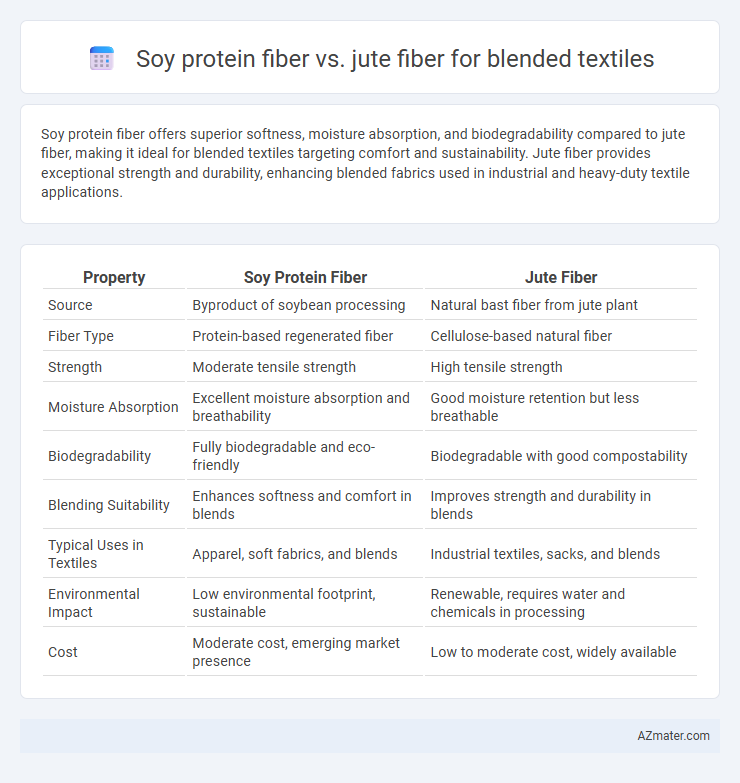Soy protein fiber offers superior softness, moisture absorption, and biodegradability compared to jute fiber, making it ideal for blended textiles targeting comfort and sustainability. Jute fiber provides exceptional strength and durability, enhancing blended fabrics used in industrial and heavy-duty textile applications.
Table of Comparison
| Property | Soy Protein Fiber | Jute Fiber |
|---|---|---|
| Source | Byproduct of soybean processing | Natural bast fiber from jute plant |
| Fiber Type | Protein-based regenerated fiber | Cellulose-based natural fiber |
| Strength | Moderate tensile strength | High tensile strength |
| Moisture Absorption | Excellent moisture absorption and breathability | Good moisture retention but less breathable |
| Biodegradability | Fully biodegradable and eco-friendly | Biodegradable with good compostability |
| Blending Suitability | Enhances softness and comfort in blends | Improves strength and durability in blends |
| Typical Uses in Textiles | Apparel, soft fabrics, and blends | Industrial textiles, sacks, and blends |
| Environmental Impact | Low environmental footprint, sustainable | Renewable, requires water and chemicals in processing |
| Cost | Moderate cost, emerging market presence | Low to moderate cost, widely available |
Introduction to Soy Protein Fiber and Jute Fiber
Soy protein fiber, derived from soybean protein, offers a soft texture and excellent moisture absorption, making it ideal for blended textiles that prioritize comfort and sustainability. Jute fiber, obtained from the jute plant stalks, is known for its strength, durability, and coarse texture, commonly used to enhance the robustness of blended fabrics. Combining soy protein fiber with jute fiber in textiles creates eco-friendly materials that balance softness with tensile strength, suitable for diverse applications in fashion and upholstery.
Origin and Production Methods
Soy protein fiber is derived from the by-products of soybeans, utilizing aqueous extraction and spinning processes to convert soy protein into fibers suitable for blending with textiles. Jute fiber originates from the bast of the Corchorus plant, harvested primarily in Bangladesh and India, and processed through water retting followed by mechanical stripping to extract long, coarse fibers. The production of soy protein fiber emphasizes sustainable use of agricultural residues with chemical and mechanical treatments, while jute fiber relies on traditional retting and manual extraction methods reflecting its natural, coarse texture ideal for blended fabrics.
Physical and Mechanical Properties Comparison
Soy protein fiber exhibits superior softness, moisture absorption, and elasticity compared to jute fiber, making it ideal for blended textiles requiring comfort and flexibility. Jute fiber offers higher tensile strength and abrasion resistance, enhancing the durability and structural integrity of fabric blends. Combining soy protein and jute fibers optimizes physical properties by balancing softness with mechanical strength, improving overall textile performance.
Environmental Impact and Sustainability
Soy protein fiber offers biodegradability and lower water consumption during production compared to jute fiber, making it a more environmentally friendly option for blended textiles. Jute fiber, while also biodegradable and renewable, requires more extensive pesticide use and longer cultivation periods, impacting soil health and biodiversity. Blending soy protein with jute fiber can enhance fabric durability while optimizing sustainability by reducing overall ecological footprints in textile manufacturing.
Blending Compatibility with Other Textile Fibers
Soy protein fiber exhibits excellent blending compatibility with cotton, polyester, and wool, enhancing fabric softness and moisture absorption in blended textiles. Jute fiber blends well with cotton and wool, contributing strength and durability but often requires chemical treatment to reduce coarseness and improve blending uniformity. The choice between soy protein and jute fibers depends on the desired balance of softness, strength, and processing ease in the final blended textile product.
Comfort and Wearability in Fabrics
Soy protein fiber offers superior softness and moisture-wicking properties, enhancing comfort in blended textiles compared to jute fiber. Jute fiber provides durability and breathability but tends to be coarser, which may affect wearability and skin feel. Combining soy protein fiber with jute results in fabrics that balance strength with improved softness, ideal for comfortable and wearable textiles.
Dyeability and Color Fastness
Soy protein fiber exhibits superior dyeability due to its protein-based structure, enabling excellent absorption of various dyes and resulting in vibrant, rich colors. In contrast, jute fiber, composed mainly of cellulose, shows moderate dye uptake but tends to produce duller shades and requires harsher chemical treatments for effective dyeing. Soy protein fiber blends generally demonstrate enhanced color fastness, maintaining brightness and resisting fading better than jute-blended textiles under washing and light exposure conditions.
Cost Efficiency and Market Availability
Soy protein fiber offers higher cost efficiency in blended textiles due to lower raw material expenses and reduced processing complexity compared to jute fiber. Jute fiber, while abundant and widely available in South Asia, involves higher production and treatment costs that impact its competitive pricing in global markets. Market availability favors soy protein fiber in regions with established legume agriculture, ensuring consistent supply chains and scalability for textile blending.
Applications in the Textile Industry
Soy protein fiber offers excellent moisture absorption and softness, making it ideal for blended textiles used in apparel and home textiles, such as T-shirts, activewear, and bedding. Jute fiber, known for its durability and coarse texture, is commonly blended to produce eco-friendly packaging materials, upholstery, and rugs in the textile industry. Combining soy protein and jute fibers enhances fabric strength and comfort, expanding applications in sustainable fashion and industrial textiles.
Future Trends and Innovations in Blended Textiles
Soy protein fiber, known for its softness and moisture absorption, is increasingly blended with jute fiber to enhance textile durability and eco-friendliness. Future trends emphasize bio-based composites where soy protein's biodegradability complements jute's strength and coarse texture, resulting in sustainable fabrics for automotive and interior applications. Innovations include enzymatic treatments and nano-enhancements that improve fiber compatibility and functional performance in blended textiles.

Infographic: Soy protein fiber vs Jute fiber for Blended textile
 azmater.com
azmater.com